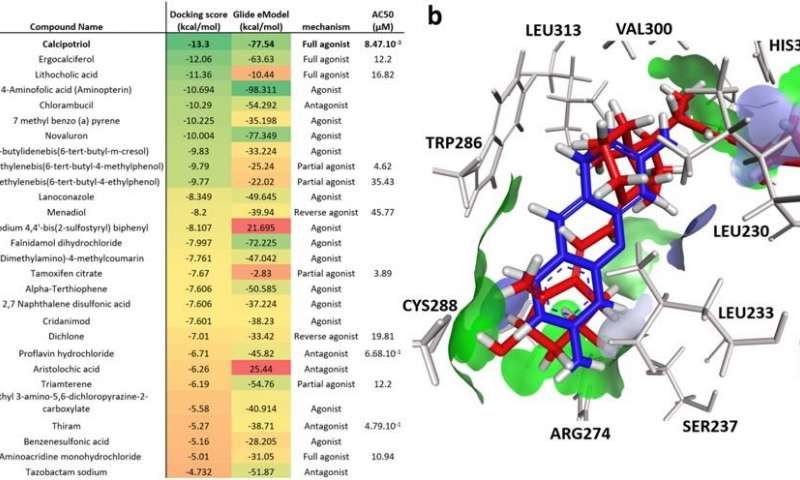
"Most people think of vitamin D as only a vitamin, but in the body vitamin D is converted to a hormone, so VDR is part of the endocrine system which regulates hormonal function," says Seth Kullman, professor of biological sciences at NC State. "If something - an endocrine disrupting chemical, for example - interferes with the hormone's function at different times of development or aging, it could drastically alter physiology of a number of important systems."
Kullman is interested in exploring the effects of environmental chemicals on vitamin D receptors. He, along with a team of researchers from NC State and the U.S. Environmental Protection Agency (EPA) looked at compounds that the Tox21 database had flagged as potential VDR disruptors.
The Tox21 database uses high-throughput screening to identify environmental chemicals that may pose a threat to human health. From a subset of over 400 compounds of interest, the researchers found 21 potential agonists (compounds that enhance activity) and 19 antagonists (compounds that inhibit activity).
The team tested the compounds in vitro and used cheminformatics computer modeling to see if they had an effect on VDR. "For a receptor to be activated, first it has to bind with a specific molecule, just as a key fits a lock," Kullman says. "The activated receptor then recruits and interacts with specific proteins. The result is that genes get turned on or off.
"The idea going in was that environmental compounds wouldn't work with these receptors because they have such high specificity," Kullman continues. "We were wrong. The compounds we selected from Tox21 were able to bind with VDR and affect its function. This is important because this receptor is ubiquitously expressed through almost all cells, and vitamin D plays a role in almost all systems of the body."
Kullman and his colleagues also noted that some of the compounds had unusual effects, such as antagonists that recruited proteins and agonists that did the opposite.
"With this research we validated the Tox21 results, but it's really the first step," says Kullman. "We know that over 35 percent of the population is vitamin D deficient. Now we've identified compounds that are VDR antagonists, which could exacerbate vitamin D deficiency. What if we're exposed to these compounds? Current research shows that vitamin D deficiency is associated with diseases ranging from Alzheimers to obesity. Our next steps will be to further explore relationships between altered vitamin D signaling and disease."
The research appears in Scientific Reports.



What is the first 'death thought'?
Is it not the taking of an image of (self) reality for the Living One?
Is not protecting self in image as IF the whole, against the seeming intrusions, violations and threats to such narrative the subduing of pests, rivals and 'weeds' - so as to assert the rights of profit in gratifications of the personal sense of power?
W hat is the drive of a separated sense of self but union? And is that not sought for in a separated world as domination, possession and control?
The fixation OUT and AWAY from self is the persistence of a lack of true foundation as an imposter.
The apple of the tree of life remains unrecognised and unshared under the spell of a sense of personal power meeting division and subjection.
Power operates through the balance point(s) of the whole.
Illusion of power has to maintain the polarised play of attempt to force life to fit a dead thinking - in order to seem to live in your stead.
You are the power to accept thought by acting from it or put it behind you in the act of choosing a better or more truly aligned expression/reflection.
Oh I know - where's the biochemistry!
Perhaps we simply are living the end of an epoch, but is an 'end' a harvest rather than a 'cessation and loss of self/experience'?
I see that our beliefs operate the conditioning that to us sets the human 'condition'. I do not feel to invest in fear-defined sense of self and life - but I do feel the need to uncover this in all its forms.
How would Life 'resolve' or 'undo' blocks to true function - given true willingness to accept true function?
Anyway at all - but as a side-effect of embracing the Living of being and not as a result of leveraging the forms - and of course the willingness for Life can awaken amidst the energetic honesty of conflicted struggle - but it isn't the struggle that achieves the grace of being.
Form based thinking sets conditions that rule out all but a trickle of life. Joy-based thinking is not a narrative control but a field of alignment. Perhaps 'Satan' operates the dark side of a love of form for fantasy at expense of true to open the possibility of CHOOSING the true. This is acceptance of consciousness of a different order is it not?
I don't indulge in fear porn and yet I look AT the terror symbols so as to break the spell.
Messing with 'source code' is a recipe for most fundamental suffering.
If you eat this 'apple' you get to terrify yourself and be-live it.
So do not mess with 'source code' now. Watch your behaviours, feelings and underlying beliefs and definitions to identify what does not truly belong upon the altar of your desire. For what you want as the set or focus of your desire, is the measure and framing of your resulting experience.
S elf-hate or judgement can take many forms. If this gives 'energy' or support to hateful outcomes in our world in ways we do not currently realize, then there is a deeper responsibility to awaken as.
The negative 'economy' is profit from destruction and sickness and sacrifice - that operates as a sense of power and protection.